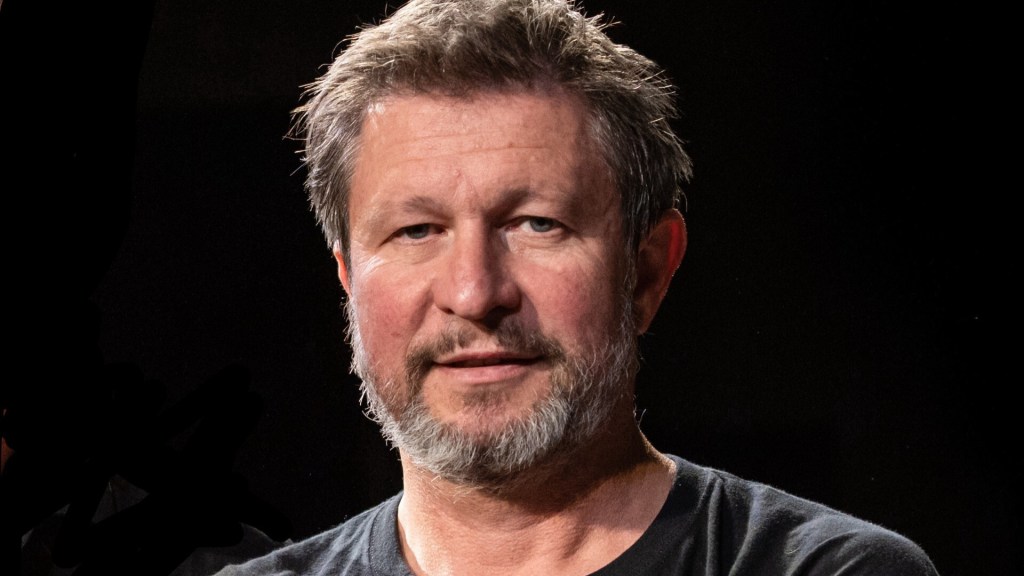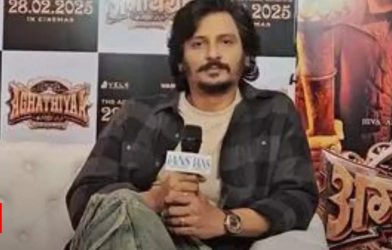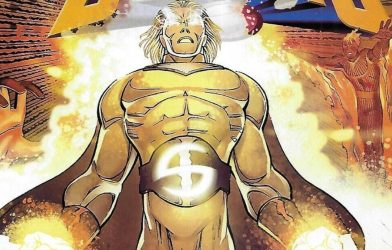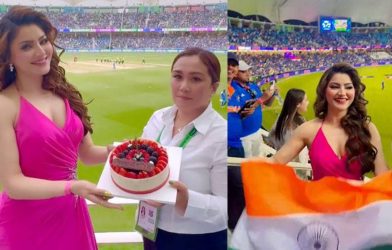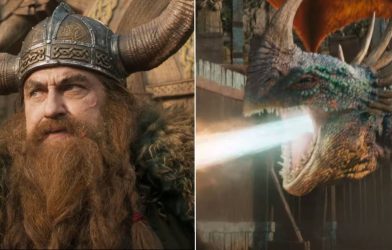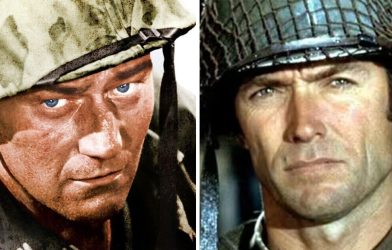
Michal Caban
Courtesy of Vaclav Beran
Attendees of the Karlovy Vary International Film Festival (KVIFF) tend to rave about the lineup of stars attending, the celebratory, even party, atmosphere that takes over the picturesque Czech spa town during the event – and those action-packed opening ceremonies.
Past years have seen the likes of ice skaters, horses, flames, and bloodbaths getting the fest off to the races with a bang and leaving guests breathless. This year’s 58th edition of KVIFF kicked off on Friday with a kind of best-of collection of characters and themes from past ceremonies.
As has become tradition, the fun and excitement is served up by the Caban brothers. They are Michal Caban, director of opening and closing ceremony, KVIFF, director, choreographer, and master of ceremonies, and his brother Šimon Caban, co-director of opening and closing ceremony, KVIFF, architect, stage designer, and director.
Michal Caban, in an email interview, told THR about the duo’s inspirations, challenges they have faced with some of their daring stage shows, how the annual magic comes together thanks to a Rapid Action Unit, and his other work, including at the Paris Summer Olympics.
You have done so many wild and exciting Karlovy Vary film festival opening shows – with ice skaters, fire, vertical dancing and more – which always seem to leave the audience breathless and in awe. How do you get your inspiration every year?
I am not alone in this. I’ve been doing the opening shows with my brother Simon for the past 28 years. This gives us a great advantage because at least one of us comes up with something every time. And fortunately, we’ve had enough ideas for now. Our festival and brotherly collaboration stems from our joint theater project, Baletni jednotka Krec (Ballet Unit Cramp). We founded this group in the 1980s and defined that we like big, dynamic pictures full of a strong atmosphere. And I think we brought that over to the festival.

Ice skaters at the Karlovy Vary International Film Festival
Georg Szalai
Do you ever worry you could run out of ideas? And do you remember any shows when inspiration came to you in a particularly unusual or funny way?
Sometimes the idea comes later, but we don’t worry about not having one. Quite often, during the realization of [the show of] a given year, an idea for another show comes. Usually, we have several perspectives, and then in a joint discussion with my brother, we focus on one. Inspiration comes from everywhere – we just look, we perceive, but most importantly we have a pretty vivid imagination. I was watching TV one day, and there was a report from some world championship in pair jumping on trampolines. Actually, I didn’t know at the time that such a thing, synchronized trampoline jumping, even existed. So I thought, let’s do it with more people, a little dance-like, different moves… and that was it. The curtain opened, four men were hanging in the air, and suddenly they were let go from a great height, the hall gasped… and then they landed on four big trampolines.
Another time, in the summer, I watched our young children slide around the garden on plastic strips of some sort of slides, which were being watered. It was on a flat surface and it was going like crazy… So we created more slides in the Great Hall of the Thermal Hotel and we let it rain down from above. Quite fun and quite dangerous. Water and electricity don’t like each other…
And sometimes you have to let ideas ripen. For example, last year’s opening show with ice skaters was something we thought of about 15 years ago, but back then the technology with artificial ice wasn’t far enough along to make it happen… so we just waited. By the way, we’ve been working with this synchronized skating team since 2004, mostly sporting events. Did you notice the word “synchronized”? We like it in choreography and in our fraternal collaboration…
By which date or month do you have to decide on the big idea and choreography for the KVIFF opening ceremony to pull the show off? How much time do you need for the performers to practice the choreography and where do you practice with them?
The many years of cooperation with the festival management and its president, Jiri Bartoska, is based on huge trust. Of course, this was built based on good work conditions, meaning especially the freedom in creation, and also based on results, which have never disappointed. So, nobody is pressuring us, rather we ourselves try to have a vision at the beginning of the year, which we aim to present to the festival in April or so. Then we put together a team. This takes place around May.
However, [we have] almost permanent collaborators who are able to do anything with us at any time. That’s why we call them the “Jednotka Rychleho Nasazeni” (Rapid Action Unit). And because the space at Thermal is so specific, we can only rehearse parts in Prague, which we then “assemble” together on the spot. The length of rehearsals and technical preparations varies from year to year. Sometimes it’s one or two days, sometimes four or five rehearsals.
Our rehearsals differ, we don’t have a permanent space. It used to be at Czech Television, where we rehearsed, for example, with wheelchair users – that was a very unusual year. Lately, we mostly try to do most of the preparations in the halls of the MeetFactory, an alternative culture center in Prague.
When was the first year you worked on the KVIFF opening ceremony and how did you get that job initially?
In 1995, at the time when the second modern edition [of KVIFF] was being prepared under the direction of Jiri Bartoska’s team, Simon, as an architect-scenographer, was approached by the festival’s producer at the time, Rudolf Biermann, if he would like to decorate the festival in Vary. Of course, he wanted to. Simon was recommended by Ales Najbrt, a classmate from UMPRUM [the Academy of Arts, Architecture and Design in Prague], a graphic designer who had just designed the poster for the film Vasnivy bozk (A Passionate Kiss) by the aforementioned film producer. The photograph for the same poster was taken by Tono Stano.
In addition to architecture, my brother organized the opening and closing of the festival in the first year rather than directing it. It was just a technical award presentation rather than a ceremony, which I then turned it into.
After the end of the 30th edition of the festival, the Karlovy Vary International Film Festival Foundation met to evaluate the previous edition and prepare for the next one. Václav Marhoul, then director of the Barrandov Film Studio, was also a member. When it came to the question of the ceremony itself, the organization and direction of all the accompanying events, he suggested me by saying that, and I quote, “he didn’t know of anyone who could do it better.”
Since then, we have operated as a four-person creative team: Ales Najbrt as main designer of posters, program and all visuals, Tono Stano was the photographer of the poster, Simon became the architect of the festival, and I became the director of ceremonies and the organizer of many accompanying programs and social events. This was the case for many years. Today, however, only Ales Najbrt’s graphic design studio remains in its functions, and my brother and I concentrate mainly on the opening and closing shows and ceremonies.

Karlovy Vary International Film Festival opening ceremony 2019
Courtesy of Film Servis Festival Karlovy Vary
Did you ever have to sit out a year because you were too busy or is this just too much fun to miss?
Yes, we skipped one year. In 2003, after eight years of cooperation, the initial enormous enthusiasm was rather exhausted and somehow we expected things to get in order. I don’t want to dwell on it too much, because we owe a lot to the festival, but it is true that, among other things, we didn’t feel that there was a tendency to adjust the budget to the evolving demands of the times, the technical necessities and just the circumstances. My brother Simon, in his role as architect, also struggled with the same feeling. He began to feel like a storekeeper just pulling old artifacts out of storage.
In general, it was great fun, but it was also a terrible responsibility. So we decided it was best to quit while still ahead…
It was a good decision. The 38th edition was prepared by a different team, which put such a strain on the festival production, both organizationally and financially, that we returned in 2004 under much better conditions. That is, only for the ceremonies, my brother did not return as the architect of the festival.
How tricky was the discussion about the show during COVID?
The year 2020 was a frustrating one for the whole world. On March 12, 2020, the world almost came to an end as it was literally paralyzed by the [COVID-19] pandemic. Six days later, we were to present our vision for that year to Jiri Bartoska. The meeting was canceled. Everything stopped. It was clear that the festival could not take place during COVID, for the first time since its inception in 1946…
When there were signs in May that something would be done in Karlovy Vary, we thought, given the situation, we could use the empty auditorium for the first and hopefully last time.
The company Stary & Stary, which has been manufacturing the design of the festival for many years and is also our supplier of decorations, had to switch to something else. They started to disinfect premises. We wanted to use their equipment in the “Disinfection” choreography and rename our Rapid Action Unit as the “Disinfection Rapid Action Unit.”
In the end, everything was different. The festival came up with the great idea of a film showcase called Tady Vary (Vary Here), which was distributed in 96 cinemas across the Czech Republic. And so I went to Karlovy Vary this time and directed “only” the president of the festival Jiri Bartoska and moderator Marek Eben in the empty Grand Hall of the Thermal Hotel. Together we prepared a decent opening of the film showcase, which was streamed to all participating cinemas across the Czech Republic.
Was there ever a big KVIFF opening show idea that you had to change or let go because it was too crazy?
We had and have a number of ideas that we would like to use in the shows, but it will never work, because the Grand Hall is primarily a cinema, and after the opening show, we also need to screen the opening movie in full quality and with an empty space in front of the screen. It’s not a theater with a revolving stage, backstage, etc. for us to afford complicated remodelings.
That’s why I still don’t understand how in 1999 we got three hydraulic lifting platforms on the stage, which are used for example under cars in auto repair shops, that exceeded the dimensions of the entrance door. I guess we’ll never find out. Because that year the theme of the festival was a bit about the film lover Oldrich Novy, a Czech actor. And in the end, we came up with a slightly erotic, synchronized “bed” scene. The sensation when the beds erected on these platforms to a height of 7 meters was impressive.
Besides your brother, are there any other key collaborators for your KVIFF shows?
My brother Simon and I have been creating the show for 29 years now, and most of that time has been spent with us by our entire production team, including costume designer Simona Rybakova, video projection designer Vojtech Kopecky, producers Ilona Labutova and Jakub Svejda and, of course, the aforementioned group of dancers associated with the Rapid Action Unit.

Šimon (left) and Michal Caban
Courtesy of Vaclav Beran
What other main work have you focused on since last year’s Karlovy Vary festival and what’s coming up for fans of your work?
Personally, I have a fairly wide range. I do the realizations for a number of social events and other ceremonies, film music concerts, co-create sports-cultural projects – just kind of jump from genre to genre. I enjoy it because it interacts in a positive way. Sometimes I test a principle at a commercial event that works well for me later at the opening show at the festival, and other times it’s vice versa.
Since last year’s festival, for example, I inaugurated the former Automatic Mills complex in Pardubice, more or less an outdoor event, I prepared a musical project of a singer of popular songs for the O2 Universum hall in the O2 Arena, the largest Czech arena, I directed a concert by opera diva Eva Urbanova, and in the same space, but on ice, I collaborated on the celebration of 120 years of the Prague ice-hockey club.
And recently, in May, during the opening show of the Ice Hockey World Championship, I prepared the cultural part of the celebration of 130 years of a Prague [soccer] club in the Trade Fair Palace, I realized two musical projects in the traditional Lucerna Hall and after this year’s festival, I will go to Paris to inaugurate the Czech House as part of the Summer Olympic Games, only to move to Cesky Krumlov, where I am filming a [Egon] Schiele dance performance on the revolving auditorium in the castle park. It’s colorful, I’m not complaining…
Is there any film and TV work you have done over your career that people can check out?
I became more involved in film and television in the 1990s. As a choreographer, I also worked on foreign films, such as Dune and Children of Dune, and as a dance troupe, the Ballet Unit Cramp, we also performed in Milos Forman’s film Amadeus in 1983.
I like the Czech films Prazská 5 (Prague 5), Kour (Smoke), Prazakum, tem je tu hej (Prague Selection), which I choreographed. In 1992, my brother Simon and I made our only feature film so far, Don Gio, about the sort of Mozart-inspired madness that occurred in the Czech Republic after the Velvet Revolution. The subtitle of the film was “Expressive, morally cultural horror”… which speaks for itself.
My brother and I have made several dance films for Czech Television, and the film KusPoKusu (PieceByPiece) won the Screendance award in Cologne, Germany. I have also choreographed and conceptualized a number of television stage pieces set to music by Bohuslav Martinu and Erwin Schulhoff. Some of them won awards at the Golden Prague TV Film Festival. We have also made specific recordings of musical projects resulting from the collaboration of our Ballet Unit Cramp and the musical group Laura and Her Tigers – The Thomas Tracy Show, Time of Rhythms, Ritual 199X.
It was a colorful time, but today, unfortunately, the TV stations are not interested in these types of things anymore. And so we also turned to musicals and opera, but that’s another chapter.
Any other fun or scary Karlovy Vary anecdotes you can share?
I think I’ve said enough. But there’s one more thing I could mention. And that is that I have had probably one of the worst work moments also connected with the festival.
In 2007, we thought of the theme of silver fringes [hanging over the stage], which dancers could manipulate and dance with. It was glittery and impressive. Opening night was a big success. A week later, it was time to prepare for Saturday’s closing ceremony. In the Great Hall of the Thermal, the screenings ended after midnight on Friday, and by 9:00 a.m. the hall was ours again. The technicians came in to re-hang the carefully folded fringes. We know what it means when they get tangled. That’s why we did a rehearsal beforehand focusing on the storage. But – and this is the BUT – with a different type of fringe from a different supplier (cost-savings on the wrong thing). It backfired badly: the carefully folded fringes got completely tangled. Uncombable. Terrible. It was clear to us that since they were shipped all the way from Italy and weren’t cheap, there was no chance of getting new ones quickly. Quick decision – get as many temporary workers and people willing to help as possible, put a rake in their hands and comb them out…
Time was passing, the director of the TV broadcast was nervously pacing, but because we have known each other for a long time, he didn’t even “flinch” and patiently trusted us. In the meantime, I was already preparing a plan in my head, what we would replace it with, within about 7 hours, for the evening. One of the “worst” moments of our creative career…
A few dozen volunteers were quietly and patiently combing the fringe bit by bit, and we were just praying that we would be able to get at least some of the fringe ready by the start of the closing ceremony.
Before six o’clock we had to finish the work. To this day, the moment when we announced the necessary end of the sweaty effort brings tears to my eyes. Some made it, but some didn’t and had to leave the unfinished work crying.
It was heartbreaking. We didn’t have any other choice and went straight to the closing show without a single rehearsal. It worked. Thank you, all! At that time, Czech Television was still broadcasting in 4:3 format, so the picture was filled with fringes, and you couldn’t tell that the area was actually narrower than during the opening.
Interview edited for length and clarity.

Karlovy Vary International Film Festival opening ceremony 2016
Courtesy of Film Servis Festival Karlovy Vary

